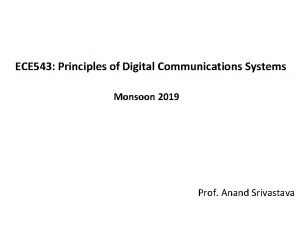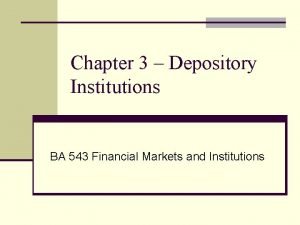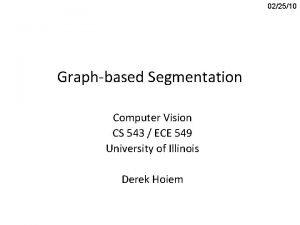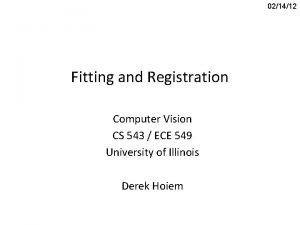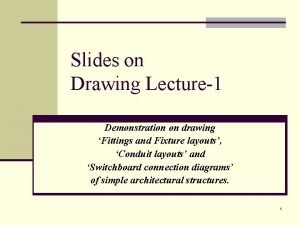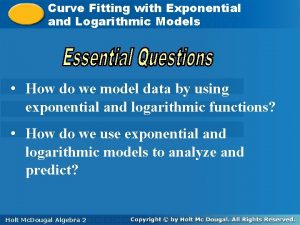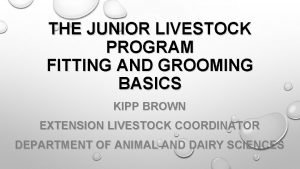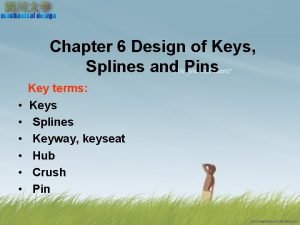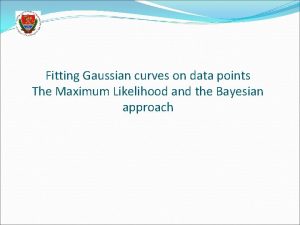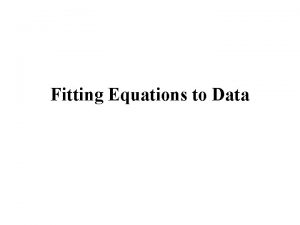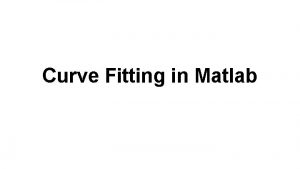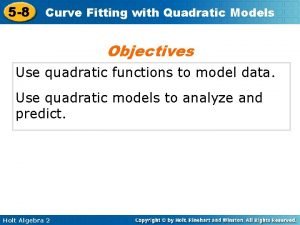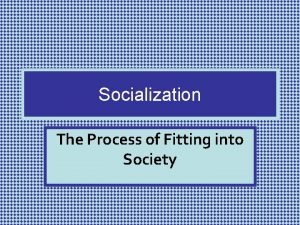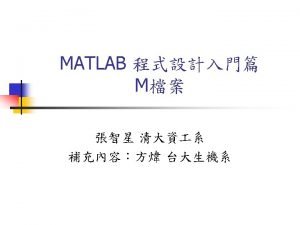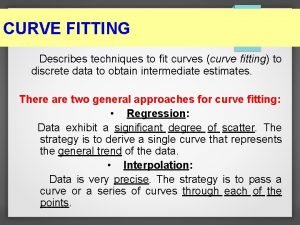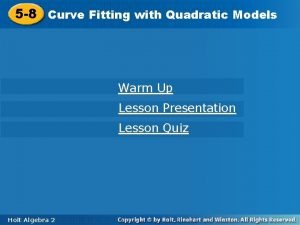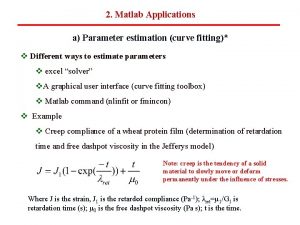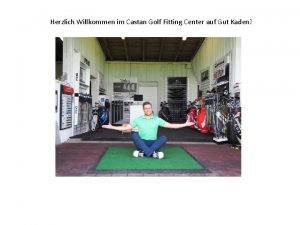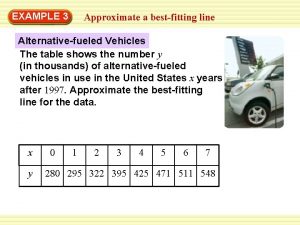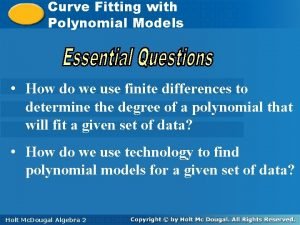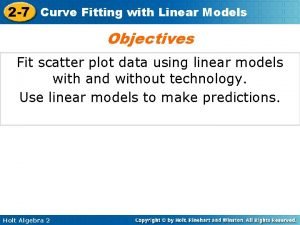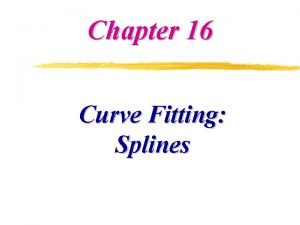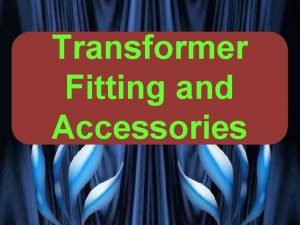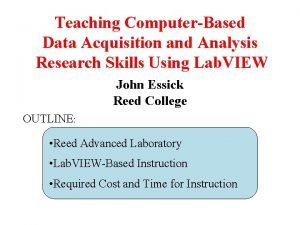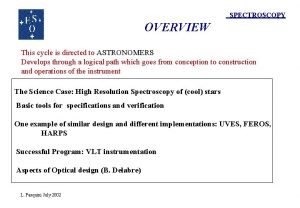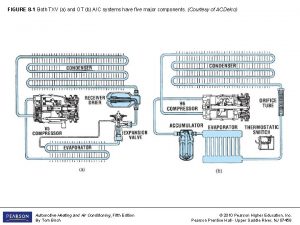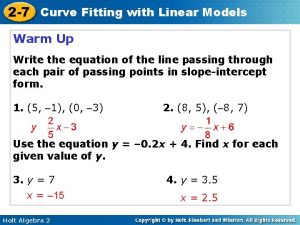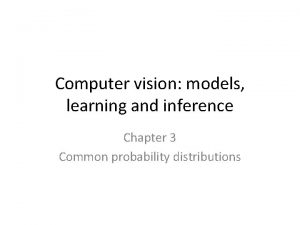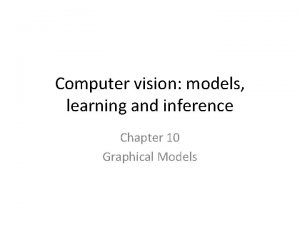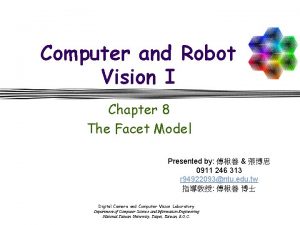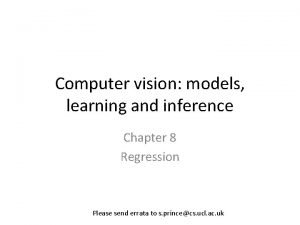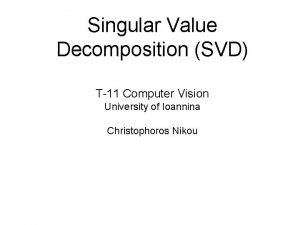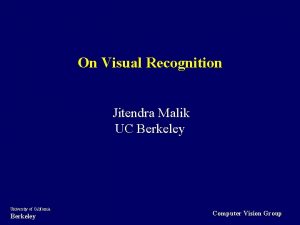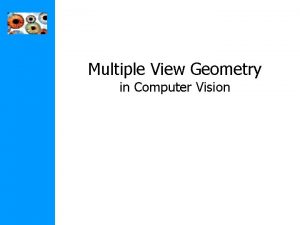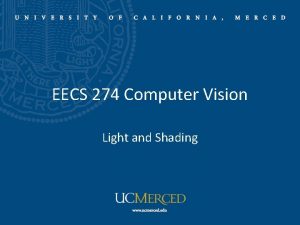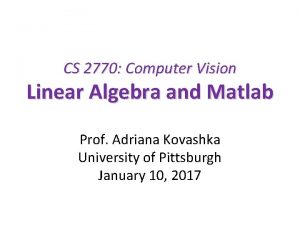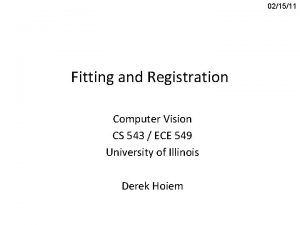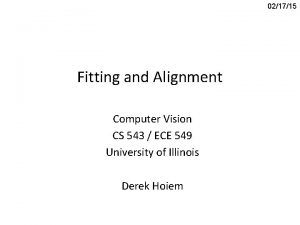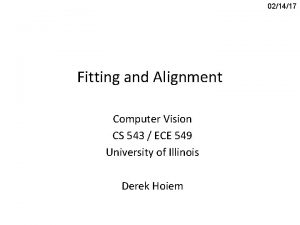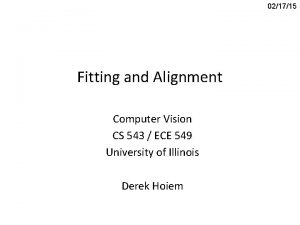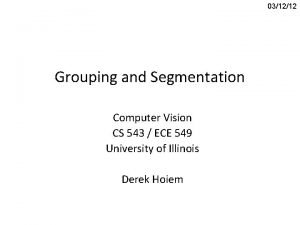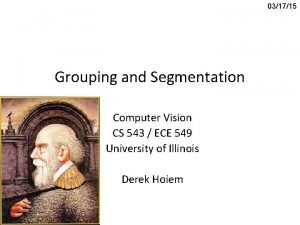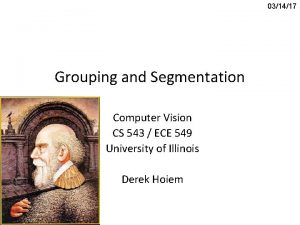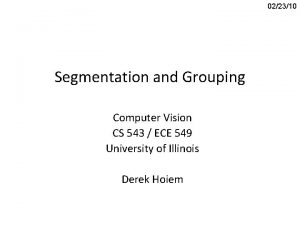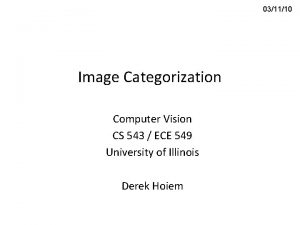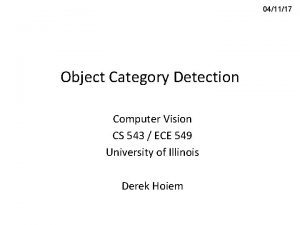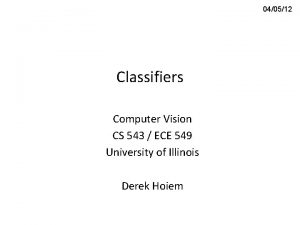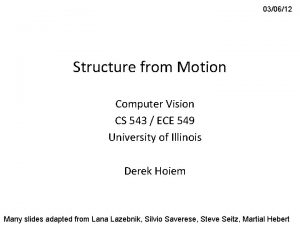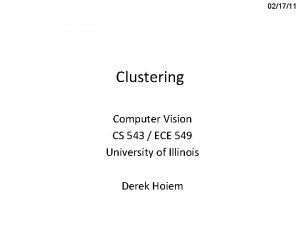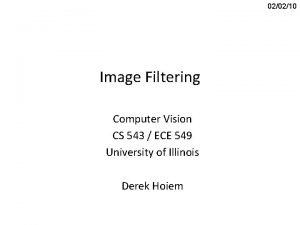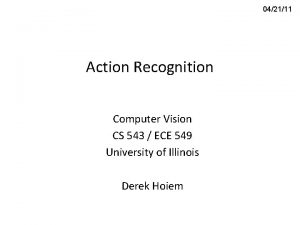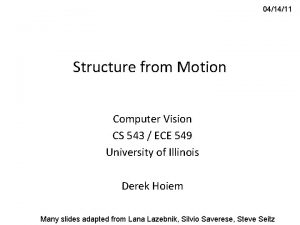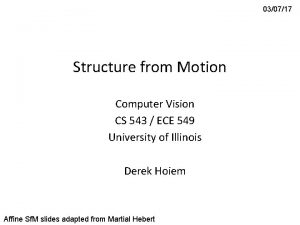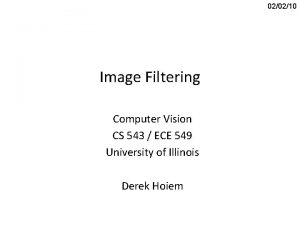021412 Fitting and Registration Computer Vision CS 543

















































- Slides: 49

02/14/12 Fitting and Registration Computer Vision CS 543 / ECE 549 University of Illinois Derek Hoiem

Announcements • HW 1 due today • Early feedback form

Fitting: find the parameters of a model that best fit the data Alignment: find the parameters of the transformation that best align matched points

Fitting and Alignment • Design challenges – Design a suitable goodness of fit measure • Similarity should reflect application goals • Encode robustness to outliers and noise – Design an optimization method • Avoid local optima • Find best parameters quickly

Fitting and Alignment: Methods • Global optimization / Search for parameters – Least squares fit – Robust least squares – Iterative closest point (ICP) • Hypothesize and test – Generalized Hough transform – RANSAC

Simple example: Fitting a line

Least squares line fitting • Data: (x 1, y 1), …, (xn, yn) • Line equation: yi = m xi + b • Find (m, b) to minimize y=mx+b (xi, yi) Matlab: p = A y; Modified from S. Lazebnik

Problem with “vertical” least squares • Not rotation-invariant • Fails completely for vertical lines Slide from S. Lazebnik

Total least squares If (a 2+b 2=1) then Distance between point (xi, yi) is |axi + byi + c| proof: http: //mathworld. wolfram. com/Point. Line. Distance 2 -Dimensional. html Slide modified from S. Lazebnik ax+by+c=0 (xi, Unit normal: yi) N=(a, b)

Total least squares If (a 2+b 2=1) then Distance between point (xi, yi) is |axi + byi + c| Find (a, b, c) to minimize the sum of squared perpendicular distances Slide modified from S. Lazebnik ax+by+c=0 (xi, Unit normal: yi) N=(a, b)

Total least squares Slide modified from S. Lazebnik Find (a, b, c) to minimize the sum of squared perpendicular distances ax+by+c=0 (xi, Unit normal: yi) N=(a, b) Solution is eigenvector corresponding to smallest eigenvalue of ATA See details on Raleigh Quotient: http: //en. wikipedia. org/wiki/Rayleigh_quotient

Recap: Two Common Optimization Problems Problem statement Solution (matlab) Problem statement Solution

Least squares (global) optimization Good • Clearly specified objective • Optimization is easy Bad • May not be what you want to optimize • Sensitive to outliers – Bad matches, extra points • Doesn’t allow you to get multiple good fits – Detecting multiple objects, lines, etc.

Robust least squares (to deal with outliers) General approach: minimize ui (xi, θ) – residual of ith point w. r. t. model parameters θ ρ – robust function with scale parameter σ The robust function ρ • Favors a configuration with small residuals • Constant penalty for large residuals Slide from S. Savarese

Robust Estimator •

Demo – part 1

Other ways to search for parameters (for when no closed form solution exists) • Line search 1. 2. • Grid search 1. 2. • For each parameter, step through values and choose value that gives best fit Repeat (1) until no parameter changes Propose several sets of parameters, evenly sampled in the joint set Choose best (or top few) and sample joint parameters around the current best; repeat Gradient descent 1. 2. Provide initial position (e. g. , random) Locally search for better parameters by following gradient

Hypothesize and test 1. Propose parameters – – – Try all possible Each point votes for all consistent parameters Repeatedly sample enough points to solve for parameters 2. Score the given parameters – Number of consistent points, possibly weighted by distance 3. Choose from among the set of parameters – Global or local maximum of scores 4. Possibly refine parameters using inliers

Hough Transform: Outline 1. Create a grid of parameter values 2. Each point votes for a set of parameters, incrementing those values in grid 3. Find maximum or local maxima in grid

Hough transform P. V. C. Hough, Machine Analysis of Bubble Chamber Pictures, Proc. Int. Conf. High Energy Accelerators and Instrumentation, 1959 Given a set of points, find the curve or line that explains the data points best y m x y=mx+b Hough space b Slide from S. Savarese

Hough transform y m b x y m 3 x Slide from S. Savarese 5 3 3 2 2 3 7 11 10 4 3 2 1 1 0 5 3 2 3 4 1 b

Hough transform P. V. C. Hough, Machine Analysis of Bubble Chamber Pictures, Proc. Int. Conf. High Energy Accelerators and Instrumentation, 1959 Issue : parameter space [m, b] is unbounded… Use a polar representation for the parameter space y x Hough space Slide from S. Savarese

Hough transform - experiments features votes Slide from S. Savarese

Hough transform - experiments Noisy data features votes Need to adjust grid size or smooth Slide from S. Savarese

Hough transform - experiments features votes Issue: spurious peaks due to uniform noise Slide from S. Savarese

1. Image Canny

2. Canny Hough votes

3. Hough votes Edges Find peaks and post-process

Hough transform example http: //ostatic. com/files/images/ss_hough. jpg

Finding lines using Hough transform • Using m, b parameterization • Using r, theta parameterization – Using oriented gradients • Practical considerations – Bin size – Smoothing – Finding multiple lines – Finding line segments

Finding circles (x 0, y 0, r) using Hough transform • Fixed r • Variable r

Hough transform conclusions Good • Robust to outliers: each point votes separately • Fairly efficient (much faster than trying all sets of parameters) • Provides multiple good fits Bad • Some sensitivity to noise • Bin size trades off between noise tolerance, precision, and speed/memory – Can be hard to find sweet spot • Not suitable for more than a few parameters – grid size grows exponentially Common applications • Line fitting (also circles, ellipses, etc. ) • Object instance recognition (parameters are affine transform) • Object category recognition (parameters are position/scale)

RANSAC (RANdom SAmple Consensus) : Fischler & Bolles in ‘ 81. Algorithm: 1. Sample (randomly) the number of points required to fit the model 2. Solve for model parameters using samples 3. Score by the fraction of inliers within a preset threshold of the model Repeat 1 -3 until the best model is found with high confidence

RANSAC Line fitting example Algorithm: 1. Sample (randomly) the number of points required to fit the model (#=2) 2. Solve for model parameters using samples 3. Score by the fraction of inliers within a preset threshold of the model Repeat 1 -3 until the best model is found with high confidence Illustration by Savarese

RANSAC Line fitting example Algorithm: 1. Sample (randomly) the number of points required to fit the model (#=2) 2. Solve for model parameters using samples 3. Score by the fraction of inliers within a preset threshold of the model Repeat 1 -3 until the best model is found with high confidence

RANSAC Line fitting example Algorithm: 1. Sample (randomly) the number of points required to fit the model (#=2) 2. Solve for model parameters using samples 3. Score by the fraction of inliers within a preset threshold of the model Repeat 1 -3 until the best model is found with high confidence

RANSAC Algorithm: 1. Sample (randomly) the number of points required to fit the model (#=2) 2. Solve for model parameters using samples 3. Score by the fraction of inliers within a preset threshold of the model Repeat 1 -3 until the best model is found with high confidence

How to choose parameters? • Number of samples N – Choose N so that, with probability p, at least one random sample is free from outliers (e. g. p=0. 99) (outlier ratio: e ) • Number of sampled points s – Minimum number needed to fit the model • Distance threshold – Choose so that a good point with noise is likely (e. g. , prob=0. 95) within threshold – Zero-mean Gaussian noise with std. dev. σ: t 2=3. 84σ2 proportion of outliers e s 2 3 4 5 6 7 8 5% 2 3 3 4 4 4 5 10% 3 4 5 6 7 8 9 20% 25% 30% 40% 5 6 7 11 17 7 9 11 19 35 9 13 17 34 72 12 17 26 57 146 16 24 37 97 293 20 33 54 163 588 26 44 78 272 1177 modified from M. Pollefeys

RANSAC conclusions Good • Robust to outliers • Applicable for larger number of objective function parameters than Hough transform • Optimization parameters are easier to choose than Hough transform Bad • Computational time grows quickly with fraction of outliers and number of parameters • Not good for getting multiple fits Common applications • Computing a homography (e. g. , image stitching) • Estimating fundamental matrix (relating two views)

Demo – part 2

What if you want to align but have no prior matched pairs? • Hough transform and RANSAC not applicable • Important applications Medical imaging: match brain scans or contours Robotics: match point clouds

Iterative Closest Points (ICP) Algorithm Goal: estimate transform between two dense sets of points 1. Initialize transformation (e. g. , compute difference in means and scale) 2. Assign each point in {Set 1} to its nearest neighbor in {Set 2} 3. Estimate transformation parameters – e. g. , least squares or robust least squares 4. Transform the points in {Set 1} using estimated parameters 5. Repeat steps 2 -4 until change is very small

Algorithm Summary • Least Squares Fit – closed form solution – robust to noise – not robust to outliers • Robust Least Squares – improves robustness to noise – requires iterative optimization • Hough transform – robust to noise and outliers – can fit multiple models – only works for a few parameters (1 -4 typically) • RANSAC – robust to noise and outliers – works with a moderate number of parameters (e. g, 1 -8) • Iterative Closest Point (ICP) – For local alignment only: does not require initial correspondences

Example: solving for translation A 1 A 2 A 3 B 1 B 2 B 3 Given matched points in {A} and {B}, estimate the translation of the object

Example: solving for translation A 1 A 2 A 3 (tx, ty) B 1 B 2 Least squares solution 1. Write down objective function 2. Derived solution a) Compute derivative b) Compute solution 3. Computational solution a) Write in form Ax=b b) Solve using pseudo-inverse or eigenvalue decomposition B 3

Example: solving for translation A 1 A 2 A 5 B 4 A 3 (tx, ty) A 4 B 1 B 2 B 5 Problem: outliers RANSAC solution 1. 2. 3. 4. Sample a set of matching points (1 pair) Solve for transformation parameters Score parameters with number of inliers Repeat steps 1 -3 N times B 3

Example: solving for translation B 4 A 1 A 2 B 5 (tx, ty) A 3 B 1 B 2 A 4 A 5 B 6 B 3 A 6 Problem: outliers, multiple objects, and/or many-to-one matches Hough transform solution 1. Initialize a grid of parameter values 2. Each matched pair casts a vote for consistent values 3. Find the parameters with the most votes 4. Solve using least squares with inliers

Example: solving for translation (tx, ty) Problem: no initial guesses for correspondence ICP solution 1. 2. 3. 4. Find nearest neighbors for each point Compute transform using matches Move points using transform Repeat steps 1 -3 until convergence

Next class: Object Recognition • Keypoint-based object instance recognition and search
 Structured light
Structured light Level 5 health and social care research project examples
Level 5 health and social care research project examples Ece 543
Ece 543 Uiuc cs 543
Uiuc cs 543 543 machine
543 machine Ba 543
Ba 543 Ba 543
Ba 543 Ba 543
Ba 543 Cs 543
Cs 543 Hough transform
Hough transform Conduit layout diagram
Conduit layout diagram Curve fitting with exponential and logarithmic models
Curve fitting with exponential and logarithmic models Steer clipping and fitting techniques
Steer clipping and fitting techniques Taper key design
Taper key design Wwglass
Wwglass Gaussian curve fitting
Gaussian curve fitting Fitting equations to data
Fitting equations to data Curve fitting matlab
Curve fitting matlab Quadratic curve fitting
Quadratic curve fitting Fitting into society
Fitting into society Matlab sine fitting
Matlab sine fitting Curve fitting techniques
Curve fitting techniques Curve fitting with quadratic models
Curve fitting with quadratic models Matlab curve fitting
Matlab curve fitting Castan golf fitting
Castan golf fitting Approximate the best fitting line for the data
Approximate the best fitting line for the data Curve fitting with polynomial models
Curve fitting with polynomial models Curve fitting with linear models
Curve fitting with linear models Professional shoe fitting
Professional shoe fitting Butler heating and air
Butler heating and air Matlab spline interpolation
Matlab spline interpolation Transformer fittings and accessories
Transformer fittings and accessories Labview curve fitting
Labview curve fitting Primordial nucleosynthesis
Primordial nucleosynthesis A/c fitting size chart
A/c fitting size chart Curve fitting with linear models
Curve fitting with linear models Computer vision: models, learning, and inference
Computer vision: models, learning, and inference Mathematical foundations of computer graphics and vision
Mathematical foundations of computer graphics and vision Computer vision: models, learning, and inference
Computer vision: models, learning, and inference Computer vision: models, learning, and inference pdf
Computer vision: models, learning, and inference pdf Computer and robot vision
Computer and robot vision Computer vision: models, learning, and inference
Computer vision: models, learning, and inference 16-385 cmu
16-385 cmu Kalman filter computer vision
Kalman filter computer vision T11 computer
T11 computer Berkeley computer vision
Berkeley computer vision Multiple view geometry in computer vision.
Multiple view geometry in computer vision. Computer vision vs image processing
Computer vision vs image processing Radiometry in computer vision
Radiometry in computer vision Linear algebra for computer vision
Linear algebra for computer vision


